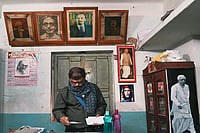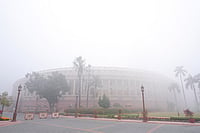Once on a flight from Dubai to Delhi, I sat alongside two Punjabi carpenters on a short visit home. Throughout the barely four-hour flight, the two pestered the stewardess with continual requests for Scotch, and insisted on calling her “waitress”, even tugging at her dress as she walked past. She was a white woman, and as full paying passengers they felt entitled to her in any way they wished. In hushed tones amid chuckling noises, they talked amongst themselves on how they would treat her if the inside of the plane was suddenly rendered completely dark. It mattered little that their offensive remarks were being overheard by everyone around them—for it was an odd badge of entitlement brought on by their new status as successful Indians settled abroad. Besides, they belonged to an old civilisation, older than anything the barbaric ancestors of the white stewardess—or waitress—could ever imagine. The new India of 7 per cent plus annual growth rate only encouraged their attitude.
In the shadow of the recent gangrape in Delhi, there are obviously many issues being raised; changes in mindset, enacting of new laws, security arrangements, police attitudes, public behaviour, additional patrolling, better street lighting, more women bus conductors. Yet, the prime cause of urban distress in Indian cities remains unaddressed—a condition that stems largely from an acute absence of public space, indeed, from the utter lack of the citizen’s participation in urban life.
By a strange coincidence, the Mercer Urban Index was published in an Indian daily just days before the Delhi gangrape. It claimed that, of all Indian cities, Delhi had the second best quality of life, after Bangalore. The poll factored in things like available infrastructure for health, education, housing, shopping, transport etc and weighed it against population size. However, of the 221 cities polled worldwide, Delhi ranked a lowly 143, ahead of Calcutta and Mumbai and some African and Latin American crime- and drug-prone cities.
That Delhi was considered one of the best in India and amongst the worst in the world indicates a serious flaw in our assessment of urban life. Certainly, the past two decades have seen a marked increase in the city’s commerce—reflected as it is in malls, vast suburban shopping and office tracts, auto and product showrooms. But the increased purchasing power of the residents has been at the expense of great social stress and a polarisation of community life—in all our cities. While the protests raged in Delhi, `12 lakh was robbed from a Chandigarh petrol dealer at gunpoint; a girl was molested in broad daylight on a suburban Mumbai train, where, as she reported later, the public watched, partly helplessly, partly in dumb participation. Rapes, burglaries and kidnappings were recorded in Ghaziabad, Lucknow, Hyderabad, Bhopal and many other places across India.
Such increasing crime in Indian cities is directly proportional to the privatisation of urban assets. More and more, city life has become a series of closed systems, where fear and insecurity confines the resident to increasingly private realms. The house is surrounded by high boundaries; it employs guards and electronic surveillance. New apartment complexes even promote community and sporting activities within the complex, creating a complete stage-set of private privilege; with pools and entertainment on the premises, social and cultural life is also privatised. The gated community, once seen as an indicator of the rising graph of crime around it, is now itself a symptom of the increasingly divided city.
As a result, the Indian city ensures that the residents remain entirely dissociated from the norms of collective living. Virtually, no social order exists outside the bounds of family. The world outside the home is a wasted place, its people and places a sort of proverbial enemy, to be tolerated but never befriended. The absence of walkable space, usable parks, libraries, meeting areas or any activity of cooperative intent makes the city merely an assortment of private houses and institutions.
No spitting. No urinating. No eatables. No littering. And now, no molestation. The need to institutionalise public behaviour and graphically display it on signboards is an inevitable necessity in a culture that has scant regard for public space, and little interest in preserving anything outside the domestic domain. You move through the city never as responsible citizens but either as disjointed gangs playing by gang rules, threatening and intimidating women, or as whole families, usurping compounds, filling restaurants, strolling in malls. Both sub-species so self-absorbed, they are incapable of surviving any other way.
That public place belongs to everyone is an oddly western notion. Every time you are abroad, you become acutely aware of your rights, your space, your trespassings. Places to eat, sidewalk cafes, parks, libraries, stadia, galleries and museums, you are in constant collision in a culture of varied offerings. You make yourself fit in, because without such an act, you become a palpable threat to public order. The structure of all public activity is governed by unwritten codes: to be silent in a library, wait your turn at a ticket counter, shout at the pub and the horse track, not at Wimbledon.
Is it a wonder then that Indians behave like unhinged free-floaters when abroad? Indian students are expelled from college dorms for cooking in their rooms and defying fire regulations. In the co-ed dorms, some are ejected for molesting female students. Indians are regularly caught on freeways breaking rules, or parking illegally. Since most such actions are considered normal at home, there is genuine bewilderment at the fines and reprimands.
All the furore over upgrading infrastructure, street lighting, adding security, reforming police, changing morals etc are piecemeal solutions to a problem that lies squarely in the social inadequacies perpetuated by the Indian city: the endless long commutes in a blind urban space that isolates and distances workplace from home, and provides no public social and cultural amenities in between. Growing cities, with increasing car and migrant populations, displaced pedestrians, and lack of public social opportunity makes for a deadly urban mix. More than ever now, the Indian city needs imaginative public-oriented solutions, ideas that add value to urban space. A social network—outside the Internet—will once again allow the residents a more intimate connection to their surroundings.
(Architect and writer Gautam Bhatia is the author, most recently, of Comic Century: An Unreliable History of the 20th Century)






















